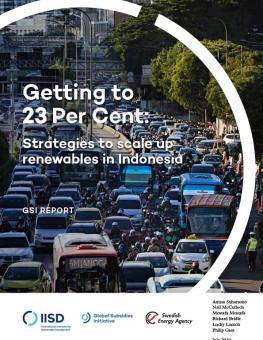
Getting to 23 Per Cent: Strategies to scale up renewables in Indonesia
This report addresses seven concrete ways in which the Indonesian government can overcome the existing obstacles and make significant progress to grow renewable energy before 2025.
-
#Indonesia has a goal to increase the share of #renewables to 23% of the national energy mix—but the country is currently off pace to meet this target.
-
If these changes are made, it is possible for #Indonesia to have an #energy policy that fulfills energy sovereignty, moves toward energy self-sufficiency and achieves energy justice for all.
Key Messages
- Indonesia has a goal to increase the share of renewables to 23 per cent of the national energy mix but is currently off pace to meet this target.
- There are a number of strategies for increasing the share of renewables. This report outlines several possible solutions, including strategies to increase solar and biomass power, reduce reliance on coal, and reforming energy pricing.
As part of the Paris Agreement, Indonesia committed to reducing greenhouse gas emissions by 29 per cent below its baseline emissions by 2030 (and by 41 per cent conditional on international support). In addition to the 23 per cent renewable energy goal, Indonesia also has a target of reaching 100 per cent electrification ratio by 2020. These targets reflect the stated desire of the Indonesian government to meet its climate change commitments under the Paris Agreement, as well as its political commitment to the Indonesian people to supply all Indonesians with electricity.
However, Indonesia is currently off target. Contrary to the government’s predictions, installed capacity additions of renewable energy power plants have been slow over the past three years. The total renewable installed capacity stood at 9.4 GW as of the end of 2018, well under the Ministry of Energy and Mineral Resources’ target of 15.5 GW by the second quarter of 2018. In 2018, the International Institute for Sustainable Development published a report identifying a series of “roadblocks” for renewable energy development in Indonesia. Moreover, the report argued that the low prices and constantly fluctuating policies were the result of a fundamental political challenge, or trilemma, facing the sector.
Despite the challenging policy environment, there are also opportunities for real progress in several areas between now and 2025. This report addresses seven concrete ways in which the Indonesian government can overcome the existing obstacles and make significant progress to grow renewable energy before 2025. In particular, to make progress it will be necessary to change the way in which key institutions operate and the incentives that they face. But if these changes are made, it is possible for Indonesia to have an energy policy that fulfills energy sovereignty, moves toward energy self-sufficiency and achieves energy justice for all.
You might also be interested in
Indonesians Are Demanding Climate Action
Thousands of people, youth especially, are calling for Indonesia and countries around the world to live up to their commitments on climate change.
The Indonesia Election Result and Joko Widodo’s New Cabinet: What it means to fossil fuel subsidy reform
Indonesia's President Joko Widodo has chosen a new cabinet to help deliver his legacy in his final term, there are big tasks ahead regarding fossil fuel subsidies and renewable energy expansion.
Energy Transition in Support of the Low-Carbon Development Initiative in Indonesia: Transport sector
Implementing an effective pricing mechanism is necessary for Indonesia to complete its landmark fuel subsidy reforms and prevent backsliding into expensive subsidy policies. The current pricing regime aims to deliver a public service but inadvertently contributes major social costs: air pollution and associated illness, greenhouse gas emissions and traffic congestion.
Switching Fossil Fuel Subsidies in Indonesia to Support a Green Recovery
This brief looks at how Indonesia can start actively promoting renewable energy by removing the existing hurdles to its deployment—such as unattractive renewable energy feed-in tariffs and land and infrastructures barriers—and switching public support from fossil fuels to renewables to meet the country’s clean energy targets.